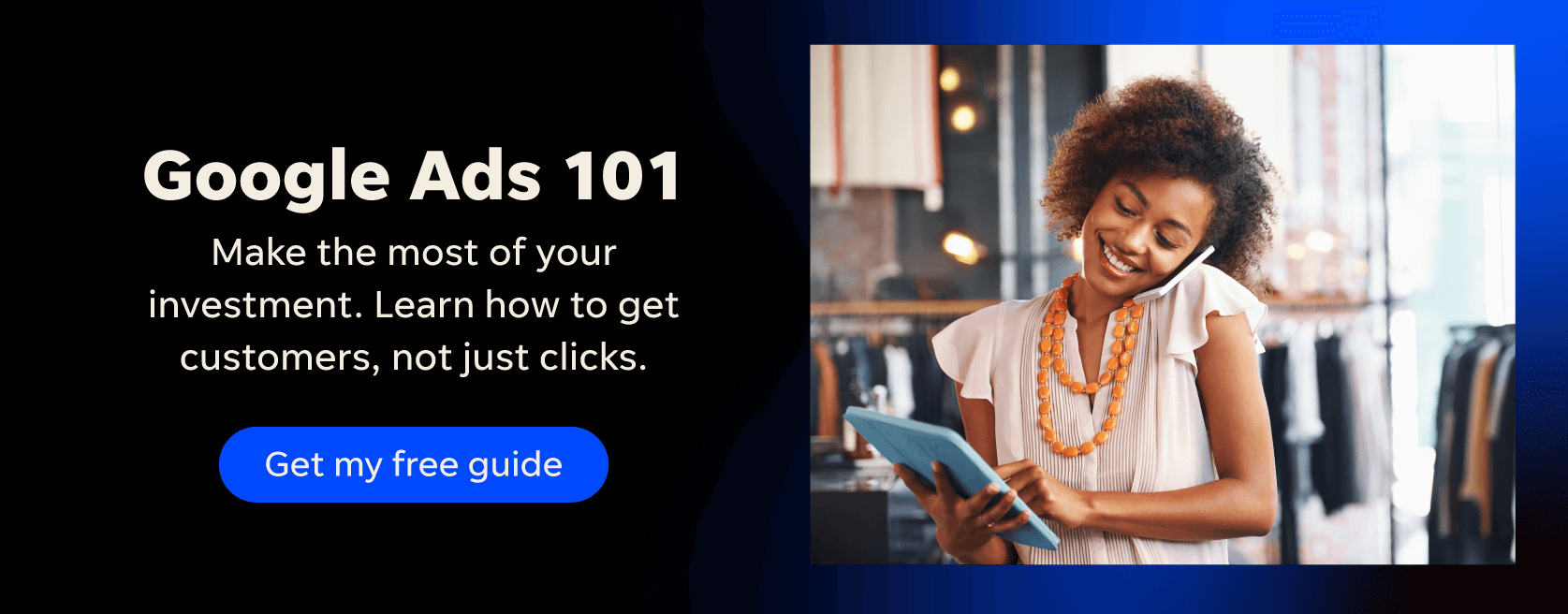I’ve been running pay-per-click (PPC) campaigns for well over 10 years now, and over that time, I’ve seen lots of hot trends come and go. There have always been big debates around campaign structure, overall strategy, match type usage, machine learning vs. manual, and more.
But over that time, there are a few fundamentals that don’t really seem to wane. In this post, I want to run through some of the foundational quick tips I view as timeless advice in PPC optimization management that many people overlook.
7 PPC optimization tips you won’t want to miss this year
Here are the top PPC optimization tips for small businesses in 2024.
1. Check your performance by network, where you can
Whether it’s new campaign types like Performance Max or Demand Gen or changes to existing campaigns like standard search or display, many campaigns are running across multiple different networks, each of them with entirely different user intentions and experiences.
While I’m not categorically opposed to any of these changes, I think it’s important to check on your network performance regularly. If you notice campaigns start to shift in performance one way or another, it may be due to changes on those networks.
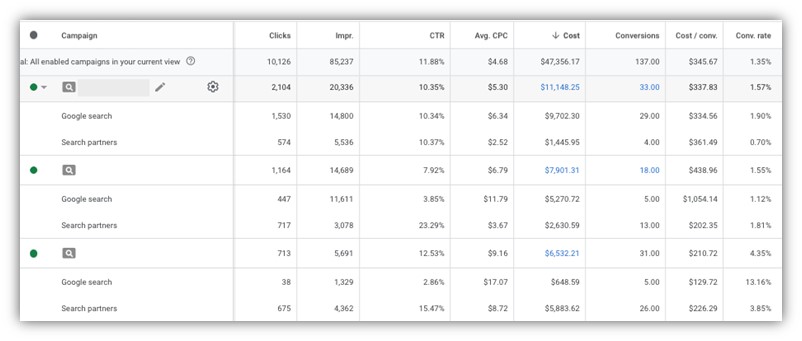
Historically, search partner networks have been very volatile for search campaigns. Sometimes they perform well and other times they’re a well of bot traffic that just doesn’t convert.

Here’s where to find your ad performance by network in Google Ads.
For Google and Microsoft, you can easily check the performance of these networks with a simple adjustment to your performance view. Head over to the Segment icon above the performance table in both platforms, then choose either “networks” (with search partners) on Google or just “network” on Microsoft, and your data will add a new row for each network.

Here’s where to find your ad performance by network in Microsoft Ads.
If the performance for these networks is strong (and not bot traffic), then keeping them on will continue to help. But if you see wasted marketing budget spend or if you’ve noticed spam traffic coming through your site, it might be worth turning these off for a bit and revisiting later.

💡 Ready for a deeper look at your Google Ads performance? Try WordStream’s Google Ads Grader for actionable insights and next steps. Get your free audit now!
2. Leverage all the messaging you’re allowed to use
The entire world is noisy and that’s no different online. In any ad placement, you’re competing with the content on the page, the things going on in someone’s environment, the thoughts swirling in their heads, and sometimes the TV show or podcast they’re listening to, not to mention all the other advertisers who are also trying to get their attention (and money).
Your ad is the only thing you have to get your brand’s message in front of the user. You can have the best PPC keyword strategy, campaign structure, landing page, etc., but if your ad gets lost, no one will ever know.
Ad formats have changed quite a bit over the last five years or so and, in my opinion, you must take advantage of every centimeter of space you can grab. In practicality, that means a few things.
For search ads specifically, we now only have Responsive Search Ads (RSAs), which are comprised of 15 potential headlines and four descriptions. Each headline can be up to 30 characters and the descriptions can be up to 90. Use them!

So many times I log into small business accounts and see RSAs with the minimum of three headlines and two descriptions. Now, while that will get your ad on the search results page, it leaves quite a bit of room to create a compelling message. Each of those components can be dynamically rotated to a different message that might make a more impactful ad from one user to another.
Don’t let these spaces go to waste. Create an ad copy testing strategy and stick with it. Develop themes, pin those assets, and start creating more meaningful ads.
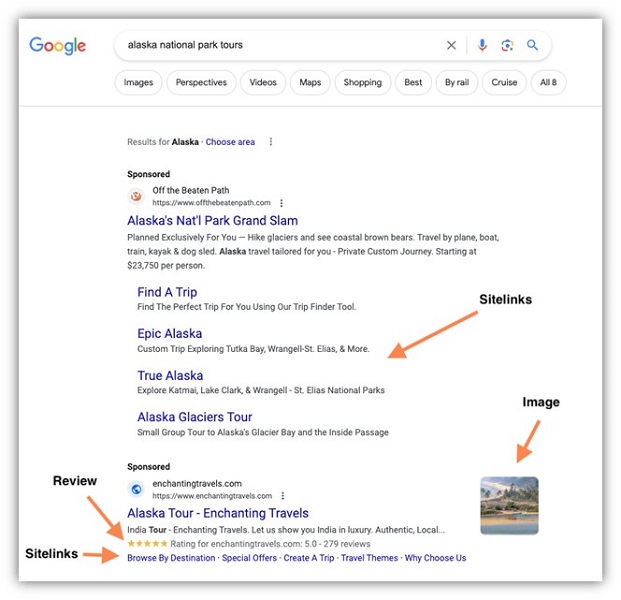
But that’s only one aspect of your ad. The other is ad assets, formerly (and more clearly) known as ad extensions. This category of messaging serves as extensions to your ad copy.

Whether it’s sitelinks, structured snippets, callouts, business name, business logo, or any of the other ad assets you can make, they should all be tools in your ad arsenal. Take the time to fill these out and start taking up more space on the SERP with more compelling messaging. Again, these are simple tools for more space on the search results page. Why not leverage it?
3. Conduct long-term reviews of keywords
It can be very easy to set up an account, manage it until you see success, and then let that success ride without revisiting the fundamentals. One thing I like to do regularly (likely quarterly, but the new year is a great time to dig in) is to review the long-term performance of the keywords in my accounts.
For all of these, look at a longer-than-average time frame. Maybe the last 90 days, last 180 days, last 365. Personally, I do all three, because you never know what might come out of the woodwork.
- What has been spending small amounts here and there that totals up to a large amount and not converting?
- What’s in the account but isn’t driving any impressions?
- What’s driving the majority of conversions and are you paying attention to it?
- What keywords have been converting at lower frequencies but total up to a meaningful amount with decent CPAs? Can you get more aggressive on those?
In some cases, you might want to pause some keywords to save spend, other times to save space in the account structure.
You may also find that you’re not actually aware of some converting keywords that should be higher on your priority list.
Either way, taking a step back and viewing keyword performance on a longer time scale can help you get more efficient and better understand the drivers of performance in your account.
🔍 Refine your keyword strategy with our ultimate guide to local keywords!
4. Test a new bidding strategy
If your campaigns are seeing really strong performance, you may not have any incentive to test a new bidding strategy. But every year, there are new adjustments made in machine learning that help the platforms automatically bid more efficiently for your target audience. Take a look at all the available options on Google Ads, for example.
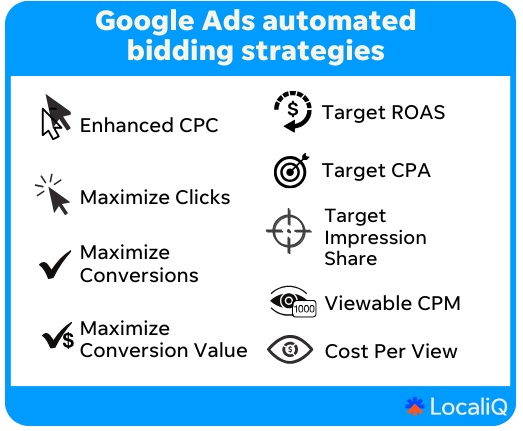
If you’re trying to maximize conversions in your campaign and you have been for a long time, maybe you want to test out a Target CPA strategy. This can help you guide your campaigns to a specific cost for conversion. On the other hand, if you’ve been running Target CPA for a while and seeing strong performance and you’re willing to let your cost per conversion increase to see more volume, you might want to test out the maximize conversions bidding strategy.
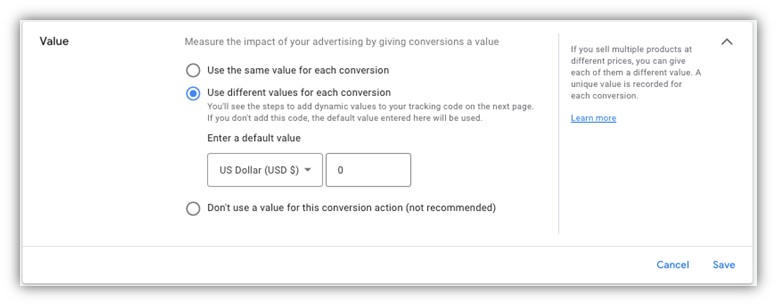
Recently, Google has been suggesting that all advertisers, even lead generation businesses, start assigning values to their conversion actions. For those not currently using this strategy, that could open up both the maximize conversion value and target ROAS bidding strategies where the focus is on the revenue associated with each conversion rather than the conversion itself.

This is not to say that what is new is always best, but it’s pretty easy to set up a new Google Ads campaign experiment to test a new strategy. You can even limit the volume of traffic going to that new strategy. So if you’ve been using the same strategies for a while and need something shaken up, bidding strategies could be an easy option.
5. Evaluate your auto-applied recommendations
In recent years, Google and Microsoft have been giving recommendations for optimizations that you could be making for your accounts. But did you know that sometimes they go further, automatically applying those recommendations for you?
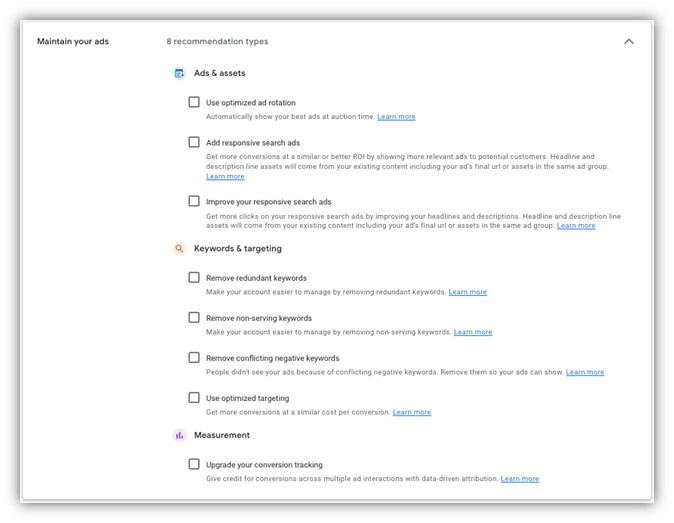
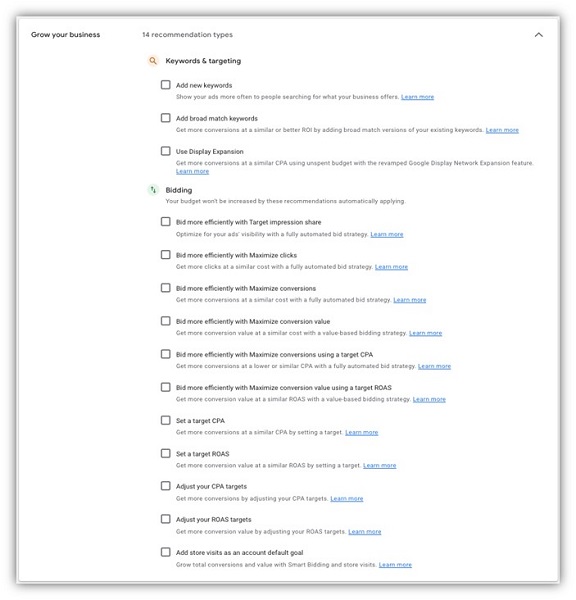
All of the suggestions they may or may not apply for you can be found on the recommendations tab in your accounts, but it’s up to you if you want to execute those changes yourself or have the platforms do it for you.
Some of these recommendations might be meaningful and have a positive impact on your account, but not all of them always will. My approach to these recommendations is in the next section, but for now, we need to know how to turn off the automatic updates.

In Google Ads, you can navigate to the setting around auto-applied by going to the Recommendations tab and clicking the Auto Apply icon in the upper right. You can then view all recommendations that are currently being applied and uncheck the box next to any that you don’t wish for the platforms to make on your behalf.
I’ve written in the past about the automatic recommendations that the platforms will make for your campaigns and whether you should use them or not. So if you’re interested in learning more about that and reading my opinion, check out the article above.
6. Review the recommendations tab for ideas
In the same vein as the recommendation above, I think it’s valuable to review the suggestions that Google and Microsoft have for your campaigns, even if I don’t think you should let them apply them for you automatically. While the recommendations themselves might follow platform best practices, and some of them may be self-serving for Google or Microsoft, that doesn’t mean that all of them are bad ideas.
![]()
In the example above, Google wants us to leverage values for our conversions. Continuing a thought from a previous section, this could open up new bidding strategies for us or simply give a better idea of return on ad spend for the campaigns. Sure, this recommendation can’t be done automatically for you by Google, so there’s no “threat” there. But since it’s not able to be automatically applied, you likely wouldn’t see this suggestion without a regular review of the recommendations tab.

Additionally, Google has a handful of recommended new keywords for us to roll out the account as well as potential new ad copy variants we could be using. I think it would take a pretty big ego to ignore any suggestions around potential keywords and ad copy without even reviewing the options. It’s free ideas with no strings attached. What’s to hate?
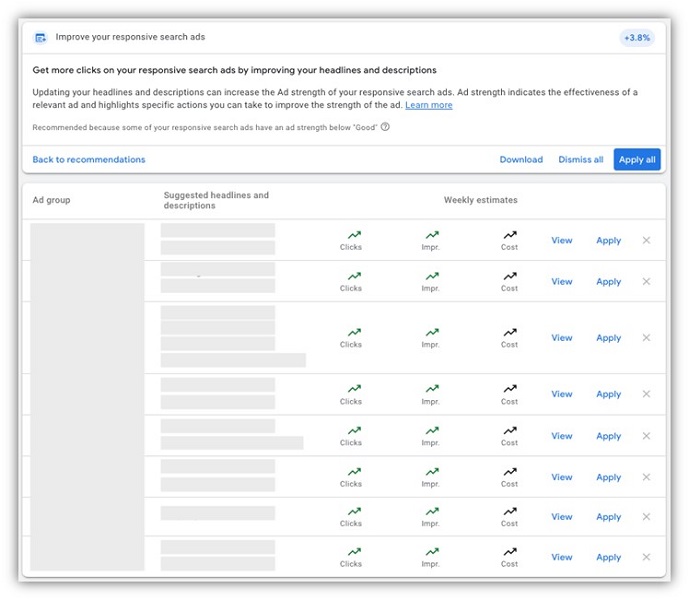
Sometimes Google suggested keywords or ad copy can open up a new path of thinking for me that improves the performance of my campaign, even if I don’t apply that recommendation from the interface. I use these recommendations as suggestions for other work projects for myself. It never hurts to conduct a little bit of keyword research or start writing new variants to test for future iterations in the account.
📊 Are your search ads performing better than your competitors’ ads? Find out with our free search ads benchmarks guide complete with key metric data for over 20 industries!
7. Make an optimization schedule
My last quick tip is a culmination of all the others I’ve discussed thus far.
Regardless of what type of campaign you’re using, there are always going to be PPC optimizations you can make and tests you can run. You might have the fanciest new setup that all the pros are squealing about, but if you run it on a “set-it-and-forget-it” mentality, you’re bound to lose out.
A quick tip: Create an optimization schedule that you can easily follow. Some tasks should be weekly, some every other week, some monthly, and some are likely quarterly or bi-annually, but the main focus is to always be reviewing what’s working, what’s not, and devise a plan to act accordingly.
You don’t have to reinvent the wheel on this either. Simply do a quick search for “PPC optimization calendar” and you’ll find all sorts of ideas people have. Mix and match the optimizations that work based on your campaign mix and make sure you’re always checking back in.
How to put these PPC optimization tips into practice
The new year is a great time to revisit some underlying assumptions you’ve had about your accounts and look to develop new potential strategies. Whether it’s quickly checking your networks, taking suggestions from the platforms, or developing a regular optimization routine with short and long time frames included, these quick PPC optimization tips can help you make the most of your accounts in 2024. If you try these PPC optimization ideas but still feel like your campaigns need a boost, see how our solutions can help you maximize your business’s PPC strategy!
Here are the top PPC optimization tips for 2024:
- Check your performance by network
- Leverage all the messaging you’re allowed to use
- Conduct long-term reviews of keywords
- Test a new bidding strategy
- Evaluate your auto-applied recommendations
- Review the recommendations tab for ideas
- Make an optimization schedule
Related Articles
-

Google Local Services Ads 101: Everything You Need to Know
-

Updated Search Advertising Benchmarks for 2024 (+Expert Tips to Improve Results)
-

Essential Beginner's Guide to Local PPC
-

9 Reasons Your Google Ads Are Failing (Exclusive Expert Insights!)
-

How Much Does Google Ads Cost in 2024? (+Tips to Lower Costs)

